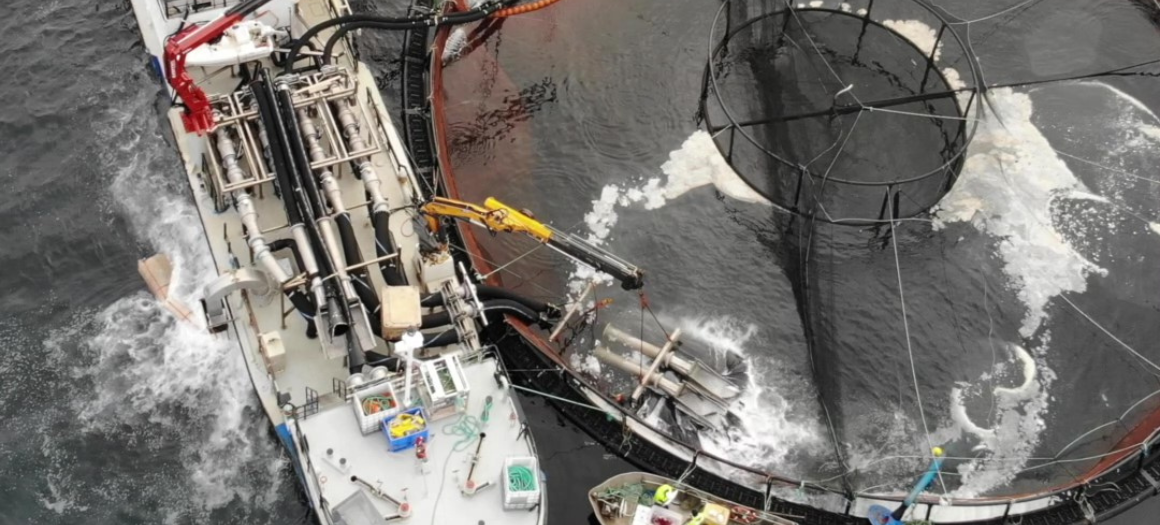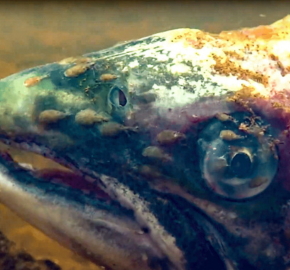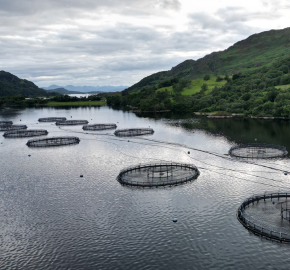Scottish salmon farming continues to expand despite failing to address key environmental and mortality issues

Record production of Scottish farmed salmon escalates risk for wild fish
In 2018, the independent Scottish Parliamentary report on the environmental impacts of salmon farming concluded that there had been “lack of progress in tackling the key issues previously identified [in 2002] and unacceptably high levels or mortalities persist”.¹
Five years on, the industry has expanded further, but again little, if anything, has been done to address the issues that directly endanger wild fish.
According to the recently published Scottish Finfish Farm Production Survey, in 2021 the annual production of Atlantic salmon in Scotland exceeded 200,000 tonnes for the first time. This represents a 7% production increase on the previous year and is equivalent to 205,393 tonnes. The industry celebrates this milestone, but the true cost – to wild fish and the wider coastal environment – of producing this volume of farmed Atlantic salmon is not to be celebrated.
In the production cycle that yielded this record tonnage, 25.6% of the fish that were transferred to marine open-net salmon cages died or were culled before they reached harvest. ² This accounts for approximately 13.5 million farmed Atlantic salmon prematurely dying and is no improvement on the mortality rates of 2002 to 2018, when it was deemed “unacceptably high”.
Disease outbreaks play a large role in the mortality issues faced by the global salmon farming industry, with huge numbers of fish dying of diseases or health conditions every year. In Scotland, some farms suffering from disease issues and outbreaks, report less than 20% of fish surviving to harvest. ³
Transmission of disease
Owing to the free flow of water through the nets they are raised in, farmed salmon are in constant contact with the surrounding marine environment. The very nature of open-net cages gives rise to a number of potentially lethal threats including transmission of infectious diseases and parasites – including sea lice.
Sea lice are external parasites which graze on the skin and mucous of fish. In high numbers these can cause pain and life-threatening ulcerations. As these lice build up in high numbers on farms, they disperse into the surrounding water, risking fatal infection of migrating wild Atlantic salmon and sea trout. ⁴ ⁵ ⁶
As the volumes of salmon being farmed along the west coast and islands of Scotland grows, so to does potential for increased sea lice loads within these waters. The farms become a breeding ground for sea lice, producing large volumes of young lice which float freely in the water until they come in contact with a host – farmed or wild.
Put simply, increasing the volume of farmed salmon in the water, provides more food for parasitic sea lice, in turn increasing their numbers and the risk to wild salmon and sea trout.
Not only do the sea lice pose an environmental risk, so to do the treatments used by the industry to manage their numbers.
Sea lice chemical bath treatments
Several chemical treatments are used to bath farmed fish to kill and or remove attached sea lice. After fish are submerged (bathed) in these treatments for varied periods of time, the chemicals and detached lice are then discharged into the surrounding water.
In some cases, such as the drug deltamethrin, the release of these chemicals can kill crustaceans such as lobsters and crabs within a 39km radius.⁷
As the industry continues to expand, the use of these chemicals to treat a growing volume of farmed salmon poses a significant risk to the Scottish west coast and islands marine ecology, and the communities and industries that reply on it.
Sea lice physical treatments
As we see in both human and veterinary medicine, drug resistance can develop with time and frequent use. In the salmon farming industry, chemical treatments are becoming increasingly ineffective as sea lice develop resistance. As such, the industry also relies on physical sea lice treatments and “cleaner fish”.
Physical delicing
As the name suggests, physical delicing involves the physical removal of lice via pressurised water jets, brush or warm water baths.
Cleaner fish
This refers to species of fish which are stocked alongside the salmon to eat the sea lice including lumpfish and wrasse (some of which are wild caught). Sadly, many of these fish do not survive in the farm environment, with mortality rates of up to 100% reported. For those that do survive the marine cycle (approx. 2 years) they are typically culled (killed and disposed of), despite some species living for over 20 years in the wild.¹⁰ As the industry grows, so too does the demand for cleaner fish; as a result this has the potential to increase the pressure on wild wrasse stocks and the impact removing these fish have on the ecosystems from which they are taken.
After years of continued expansion despite failing to resolve key environmental problems, the conclusion by the 2018 Scottish Parliament report that “The status quo is not an option” is more relevant than ever.
Open-net salmon farming is a fundamentally unsustainable and environmentally damaging industry, risking the health and welfare of both farmed and wild fish alike.
Join the campaign to ban open-net salmon farming in Scotland
List of references
- Scottish Parliament, Environment, Climate Change and Land Reform Committee. 92018). Report on the environmental impacts of salmon farming. Available from: https://archive2021.parliament.scot/S5_Environment/Inquiries/20180305_GD_to_Rec_salmon_farming.pdf
- Marine Scotland Directorate. (2022). Scottish Fish Farm Production Survey 2021, 3. Atlantic Salmon – Production. Available from: https://www.gov.scot/publications/scottish-fish-farm-production-survey-2021/pages/5/
- Salmon Scotland. (2022). Reports. Available from: https://www.salmonscotland.co.uk/reports
- Dempster, T., Overton, K., Bui, S., Stien, L., Oppedal, F., Karlsen, Ø., Coates, A., Phillips, B., Barrett, L., (2021). Farmed salmonids drive the abundance, ecology and evolution of parasitic salmon lice in Norway. Aquacult. Environ. Interact. 13, 237–248. Available at: https://doi.org/10.3354/aei00402
- Penston MJ, Davies IM. (2009). An assessment of salmon farms and wild salmonids as sources of Lepidopteries salmonis (Krøyer) copepodids in the water column in Loch Torridon, Scotland. J Fish Dis. 2009 Jan;32(1):75-88. doi: 10.1111/j.1365-2761.2008.00986.x. PMID: 19245632.
- Thorstad, E., Todd, C., Uglem, I, Bjørn, P., Gargan, P., Vollset, K., Halttunen, E., Kålås, S. (2015). Effects of salmon lice Lepeophtheirus salmonis on wild sea trout Salmo trutta—a literature review. Aquacult. Environ. Interact. 91-113. Available at: https://www.int-res.com/articles/aei2015/7/q007p091.pdf
- Parsons, A., Escobar-Lux, R., Sævik, P., Samuelsen, O., Agnalt, A. (2020). The impact of anti-sea lice pesticides, azamethiphos and deltamethrin, on European lobster (Homarus gammarus) larvae in the Norwegian marine environment, Environmental Pollution, Volume 264. Available from https://www.sciencedirect.com/science/article/pii/S0269749120302451
- Anttila, K. et al. (2014) ‘Atlantic salmon show capability for cardiac acclimation to warm temperatures’, Nature communications, 5. Available at: https://doi.org/10.1038/ncomms5252.
- Elliott, J.M. and Elliott, J.A. (2010) ‘Temperature requirements of Atlantic salmon Salmo salar, brown trout Salmo trutta and Arctic charr Salvelinus alpinus: predicting the effects of climate change’, Journal of Fish Biology, 77(8), pp. 1793–1817. Available at: https://doi.org/10.1111/j.1095-8649.2010.02762.x.
- Overton K, Dempster T, Oppedal F, Kristiansen TS, Gismervik K, Stien LH. (2019) ‘Salmon lice treatments and salmon mortality in Norwegian aquaculture: a review.’ Reviews in Aquaculture. 2019;11(4):1398–417. Available from: https://onlinelibrary.wiley.com/doi/10.1111/raq.12299
- OneKind. (2021). Cleaner Fish Welfare on Scotland’s Salmon Farms. Available from: https://www.onekind.scot/wp-content/uploads/cleaner-fish-report-final-low-res.pdf





I contacted the SSPCA (Scottish Society for the Prevention of Cruelty to Animals) in the recent past only to be told I had to have seen the conditions and cruelty first hand for them to take action!!! If it’s the case they need someone in person to have witnessed fish farm conditions first hand would it not make sense if for WildFish to provide someone who has seen it all to get in touch with the SSPCA ???
It makes sence to me that WildFish and the Scottish SPCA work together and do something about fish farms!!!
Ian MacLean Life Member